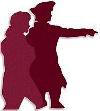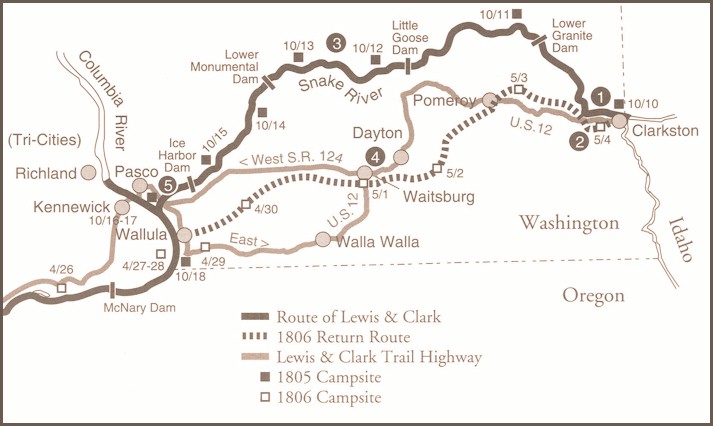|
|
"We took leave of those honest friendly people the Wallahwallahs and departed at 11 AM acccompanied by our guide the Chopunnish man and family. this plain as usual is covered with arromatic shrubs hurbatious plains and a short grass*. many of those pleants produce those esculent roots which form a principal part of the subsistence of the natives**. among others there is one which produces a root somewhat like the sweet pittaitoe***. " short grass* - The short grass is Sandberg, or western bluegrass. It is characteristic of the shrub-steppe vegetation of the Columbia Basin. natives** - The most common species with edible roots in this region include wild hyacinth; green-banded mariposa lily, Calochortus macrocarpus Dougl.; big seed lomatium (Pursh) Coult. & Rose (formerly Lewis's lomatium, Peucedanum simplex Nutt.); and cous. sweet pittaitoe*** - Cous may be the sweet potato-like plant. Other Lomatium species of the area can also be considered, including big seed lomatium, ternate lomatium, and L. watsonii Coult & Rose; they were probably used by the Indians similar to cous. May 1, 1806 "This morning we collected our horses and made an early start, haveing preveously Sent a hed 4 hunters with derections to proceed up the Creek and kill every Species of game which they might meet....at a distance of nine miles we over took our hunters, they had killed one bever only at this place the road forked, one leaveing the Creek and the Corse of it is nearly North. The Chopunnish who had accompanied us with this family informed us that this was our best way. that it was a long distance without water. and advised us to Camp on the Creek at this place and in the morning to Set out early. This information perplexed us a little, in as much as the idea of going a days march without water thro an open Sandy plain and on a Course 50º out of our derection. we deturmined to unlode and wate for our Guide, or the Chopunnish man who had accompanied us from the long Narrows, who was in the rear with Drewyer our interpreter. on his arrival we enquired of him which was the best and most direct roade for us to take. he informed us that the road pointed out by his cumerade was through a open hilly and Sandy Countrey to the river Lewis's River, and was a long ways around, and that we Cound not git any water to day. the other roade up the creek was a more derect Course, pleanty of water wood and only one hill in the whole distance and the road which he had always recomended to us. Some words took place between those two men ... Sometime after we had encamped three young men arrived from the Wallah wallah Village bringing with them a Steel trap belonging to one of our party which had been negligently left behind." May 2, 1806 "we had much difficulty in collecting our horses. at 8 AM we obtained them all except the horse we obtained form the Chopunnish man whom we seperated from yesterday.... we sent several men in differnet directions in surch of him. I engaged one of the young indians who overtook us last eveing to return in surch of him. at half after 1 PM the indian and Joseph Feilds returned with the horse, they had found him on i=his way back about 17 ms. I paid the indian the price stipulated for his services and we immediately loaded up and set forward. traveled 19 miles today. the three young men of the Wollahwollah nation continued with us." May 3, 1806 "we continued our rout... we met with We-ark-koot* whom we have usually distinguished by the name of the bighorn Cheif from the circumstances of his always wearing a horn of that animal suspended by a cord to h left arm. he is the 1st Chief of a large band of the Chopunnish nation. he had 10 of his young men with him. this man went down Lewi's rive by land as we descended it by water last fall quite to the Columbia and I beleive was very instrumental in procuring us a hospitable and friendly reception among the natives. he had now come a considerable distance to meet us. after meeting this cheif we continued still up the creek, here we encamped**. we made 28 ms. today. we divided the last of our dryed meat at dinner when it was consumed as well as the ballance of our dogs nearly we made but a scant supper and had not anything for tomorrow; however We-ark-koomt consoled us with the information that there was an indian lodge on the river at no great distance where we might supply ourselves with provisions tomorrow. our guide and the three young Wallahwollahs left us this morning reather abruptly and we have not seen anything of them since." We-ark-koot* - His real name was Apash Wyakaikt, 'apaswahayqt, "flint necklace." Men of the same name, very likely his son and grandson, were later among the most prominent Nez Perce leaders, known to whites as Looking Glass, senior and junior. The last was a leading figure in the 1977 war, in which he was killed. here we encamped** - In Garfield County, on Pataha Creek east of Pataha City, near US Highway 12 at about the point where the creek turns from a northerly to a westerly course.
May 4, 1806 "A severe frost last night; and the morning was cold and clear. We were early on our march over a handsome plain. arrived at a lodge of 6 families of which We-ark-koomt had spoken. we halted here for breakfast and with much difficulty purchase 2 lean dogs. the inhabitants were poor. a great portion of the Chopunnish we are informed are now distributed in small villages through this plain collecting the quawmash and cows; the salmon not yet having arrived to call them to the river. after dinner we continued our rout up the West side of the river 3 Ms. opposite to 2 lodges the one containing 3 and the other 2 families of the Choppunnish nation; here we met with Te-toh,ar sky* the youngest of the two cheifs who accompanied us last fall the great falls of the Columbia. here we also met with our pilot** who decended the river with us as far as the Columbia. these indians recommended our passing the river at this place and ascending the Kooskooske on the NE side. they said it was nearer and a better rout to the forkes of that river where the twisted hair resided in whose cahrge we had left our horses; thither they promised to conduct us. we determined to take the advise of the indians and immediately prepared to pass the river which with the assistance of three indian canoes we effected in the course of the evening***." Te-toh,ar sky* - Tetoharsky, a chief of the Nez Perces, who they met in October 1805 but did not name until now. our pilot** -Probably the unnamed "guide", apparently a Nez Perce, who left the party on October 18, 1805. Several Indians accompanied the Corps of Discovery for part of the journey down the Clearwater and Snake rivers and receive only casual mention in the journals. evening*** - They crossed the Snake above Silcott into Whitman County, Washington, and continued upstream on the north bank
|
|


